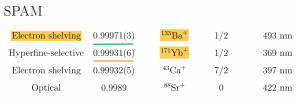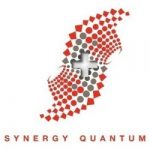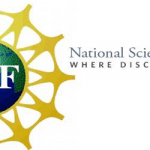From Perfect Qubit to Goldilocks Qubit for Ion Traps
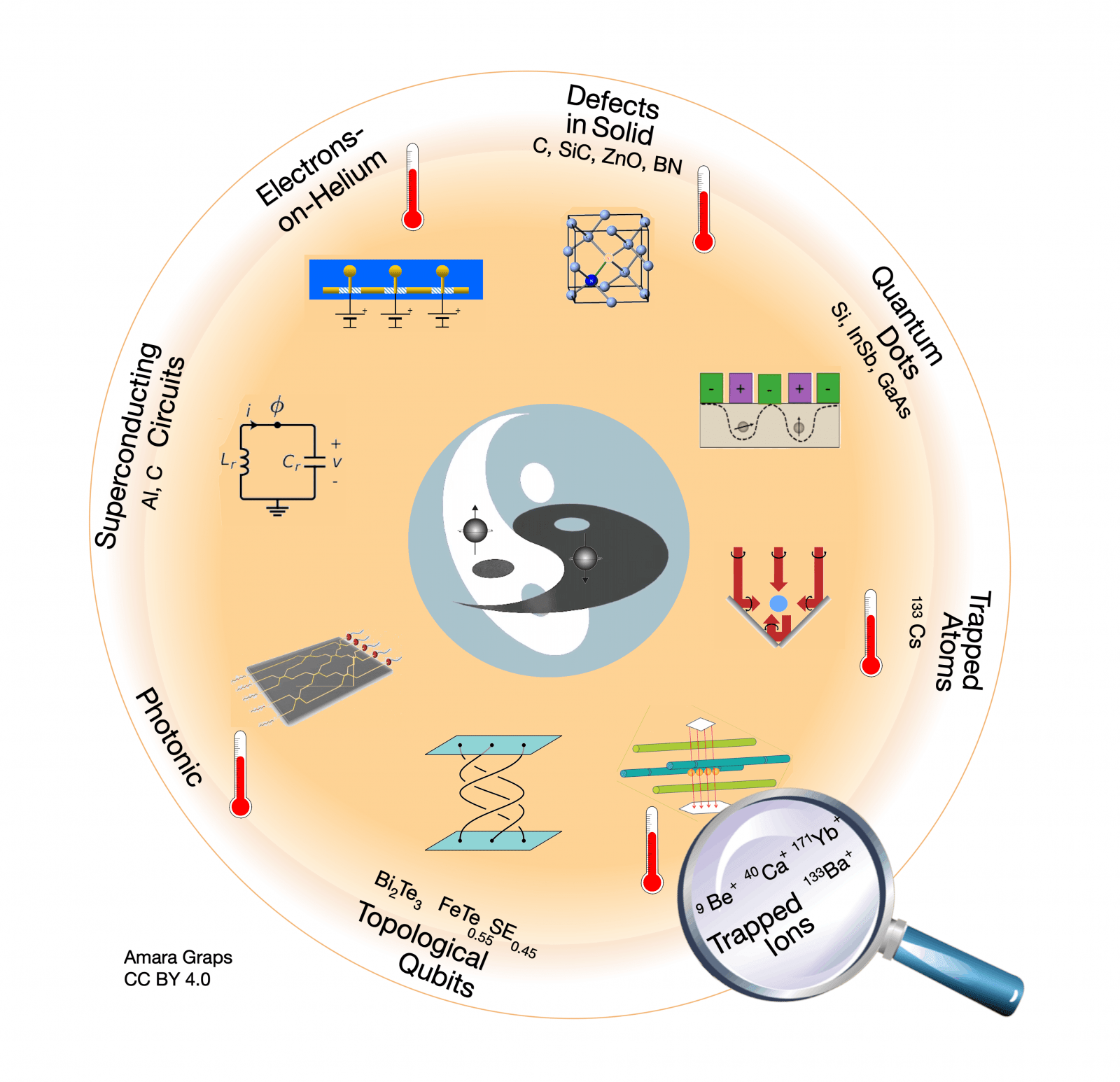
(Amara A. Graps, PhD) Last December 2021, IonQ, the first fully quantum technology company to be listed on the New York Stock Exchange, announced in a press release a new ion addition: 133Ba+ to their ion workhorse 171Yb+ (ytterbium: ee·TER·bee·uhm ) in their ion trap quantum technologies.
As 171Yb+ ions are the company’s technological foundation: 1) Patents: specifically three granted and 18 filed, 2) their deep research, and 3) the company’s co-founder: Jungsang Kim only last March 2021, calling 171Yb+ almost “the perfect qubit”, this news deserved an explanation.
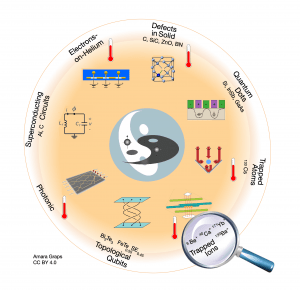
Figure 1. Mash-up art of quantum computer modalities. Concept inspired by Zhang et al, 2020, capturing a 3D Yin-Yang and embellished to indicate room temperature goals. In this article, I highlight: Trapped Ions. Graphic: Amara Graps.
Press releases are not designed to give technical details, however, and this one did not explain to which barium ion that IonQ is adding to its technology. Many thanks to: Robert Niffenegger and to QCR, who wrote: 133Ba+, the so-called: ‘Goldilocks Qubit’. Since the Goldilocks tag was known in the research literature since 2017, was there anything else about 133Ba+ that we should know?
Yes, 133Ba+ is not a naturally abundant source. 133Ba+ is a radioactive isotope, half-life: 133Ba+: 10.5 yrs, with 0 natural abundance. Therefore, this isotope must be produced, as described in Appendix A of Justin Christensen’s 2020 UCLA PhD thesis.
As 133Ba+ decays via electron capture to produce 133Cs, it needs special handling to lead-shield the user from the resultant gamma rays that are about 30 times above background levels. This might explain the puzzling reduction of 133Ba+ ion trap experiment research articles at arXiv, relative to the other barium isotopes. Christensen’s thesis solved my search; see also his synopsis at Nature for anyone wishing to understand IonQ’s new barium direction. And to move the experimentalists in the field forward, his work also demonstrates how to embed the 133Ba+ ion in the bulk of a metal to provide an easy to transport, non-reactive, confined stable source.
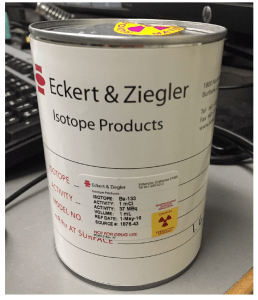
Figure 2. 133Ba+ source from Eckert & Ziegler manufactured via neutron bombardment of 132Ba. Figure A.3 of Christensen PhD thesis.
The rest of Christensen’s thesis demonstrates that a high-fidelity 133Ba+ average state preparation and measurement (SPAM) fidelity of F = 0.99971(3), was achieved, which is a factor of ≈ 2 improvement over the best-reported performance of any qubit, yes the 171Yb+. See Table below. The numbers to the right of 99.9% are important! The electron shelving method in optical qubits allow for very high detection efficiency based on resonant fluorescence to produce near unit detection of the light, i.e. higher fidelity ones and zeros.
Table 1. Highest reported SPAM fidelities for fundamental qubit operations. Selected from Table 1.1 of Christensen PhD thesis
From IonQ’s explanatory press release:
- Lower error rates, higher gate fidelity, and better state detection,
- Visible light devices are easier to source and more reliable than their ultraviolet equivalents,
- More easily networked quantum systems.
We can use the best-referenced review by Bruzewicz etal, 2019 to understand why this ion is better for their applications. For trapped ions, internal electronic states of the ion are used for the qubit states, which are generally one of four types:
- hyperfine qubits,
- Zeeman qubits,
- fine structure qubits,
- optical qubits,
Both 133Ba+ and 171Yb+ are hyperfine qubits, but 133Ba+ has characteristics of optical qubits, as well, as described in Christensen’s thesis. 133Ba+’s main transition wavelengths for the energy levels is shown in Figure 3, annotated to highlight the visible wavelengths at which lasers can be used for qubit manipulations. In contrast, for 171Yb+ ions, qubits are coupled to the atom’s 2P1/2 state, where the transition from 2P1/2 to 2S1/2 transition is 369 nm, i.e. in the ultraviolet. Furthermore, 133Ba+ ‘s has the longest energy D-state lifetimes of any alkali-earth or alkali-earth like element (τ ≈ 30 s), which lead to the ion’s high-fidelity electron shelving detection.
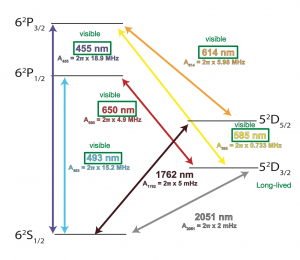
Figure 3. Gross Ba+ energy level diagram with transition wavelengths, annotated to highlight visible wavelengths. From Fig 4.1 of Christensen PhD thesis.
With IonQ’s press use of the ‘scaling’ word, it was worth to look at the status of ion trap quantum technology research and patents in the last decade.
Ion Trap Quantum Technology: Research
Since 2011, there were approximately 374 Ion Trap Quantum Computing papers posted at ArXiv, mostly stable from year-to-year, at a rate of about one per day. Meanwhile, the rest of the quantum technology field research grew fast: ~600%. As this field requires intensive laboratory work, the pandemic likely influenced recent years, with 2021 (vaccines available), reflecting twice as many papers at ArXiv as the previous year.
The necessary Ion Trap quantum equipment is expensive, however, which suggests that more frequent meetings of the North American Conference on Trapped Ions (NACTI) and European Conference on Trapped Ions (ECTI) could be helpful and grow the wide research relationships of which AJ Rasmusson yearns.
The intensive laboratory nature of the field was evident in my pursuit of 133Ba+ ion information, where, with the exception of the general Bruzewicz etal, 2019 review, PhD and MS theses proved more informative and educational than the research articles. Any press release that announces a path towards scaling, begs a look at the laboratory work to view the required equipment and processes. This rule-of-thumb might work: The larger the number of required lasers, the longer the time-to-scale. My favorites of the PhD theses, include:
- Justin Christensen: High-fidelity operation of a radioactive trapped-ion qubit, 2020. Establishes Goldilocks Qubit: 133Ba+
- Ksenia Sosnova: Mixed-Species Ion Chains for Quantum Networks. PhD. 2020. 171Yb+ as memory qubits and 138Ba+ as communication qubits.
- Kevin Antony Landsman: Construction, Optimization, and Applications of a Small Trapped-Ion Quantum Computer. PhD. 2019. First part considers the ‘scaling’ parameters for an Ion Trap Quantum Computer, based on 171Yb+ ions
- Alice Heather Burrell: High Fidelity Readout of Trapped Ion Qubits, PhD. 2010. 40Ca+ high-fidelity qubit readout, established many of the basic concepts.
- Matthew Dietrich: Barium Ions for Quantum Computation, PhD. 2009
End-to-End Ion Trap quantum computation using 137Ba+
Ion Trap Quantum Technology: Patents
The highly-skilled researchers of the ion trap quantum computing community may have jumped directly to the companies upon the completion of their academic training, because the patent activity is lively: there were about 2,834 Ion Trap quantum patent applications since 2010, with about 563 granted. As it can take about 2-3 years from application-to-grant, the growth picked up starting in 2015, because from 2018, the number of patents granted, doubled each year. The top ten patent entities:
- Honeywell International Inc. 3.3%
- Bank Of America Corporation 3.1%
- Microsoft Technology Licensing, Llc 2.9%
- Institute of Physics and Mathematics, Chinese Academy of Sciences 2.6%
- Suzhou University 2%
- Harris Corporation 1.8%
- Bristol-Myers Squibb Company 1.6%
- IonQ, Inc. 1.6%
- Rigetti & Co, Inc. 1.6%
- University Of Maryland, College Park 1.4%
Honeywell has 19 patents, with one dedicated to the 133Ba+ ion about leakage errors, granted last May 2021. While IonQ doesn’t appear to have a patent dedicated to the 133Ba+ ion yet, the company lists barium amongst others for many its patent ideas. And while it looks like Honeywell leads the percentage of ion trap quantum patents, IonQ is actually at the top place: 4.3% by virtue of its joint patents with University of Maryland (UMD: 1.4%) and Duke University (#15 1.3%). For-profit+Non-profit entities. Which brings me to my last point: Alliances.
Ion Trap Quantum Technology: Successful Alliances
A lesson, which might apply to all quantum technology companies, which seek success, is: Alliances are Key. IonQ was spun off of research from two universities, and continues its academic relationships. While IonQ does not have a patent yet with the UCLA ‘Goldilocks’ qubit group, it was a graduate student while at UMD: David Hucul, who recognized the value of 133Ba+, which led to its study at UCLA. New partnerships between IonQ and Accenture, Hyundai Motor Partner, GE, Goldman Sachs, QC Ware, SoftBank, South Korea Quantum Center were formed in the last year: 2021. Do you want quantum technology success? Collaborate!








